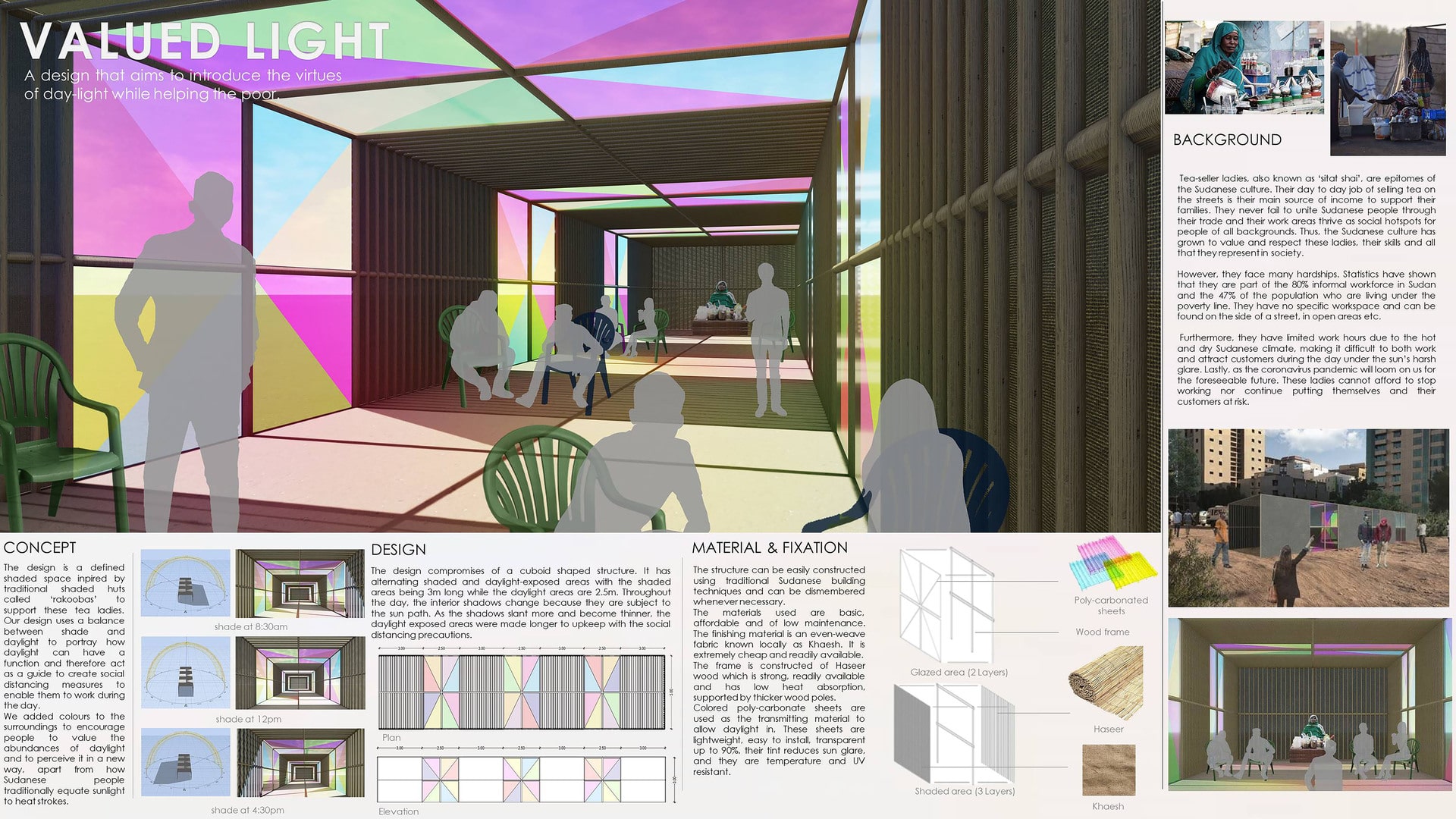Project Description
Tea-seller ladies, also known as ‘sitat shai’, are epitomes of the Sudanese culture. Their day to day job of selling tea on the streets is their main source of income to support their families. They never fail to unite Sudanese people through their trade and their work areas thrive as social hotspots for people of all backgrounds. Thus, the Sudanese culture has grown to value and respect these ladies, their skills and all that they represent in society. However, they face many hardships. Statistics have shown that they are part of the 80% informal workforce in Sudan and the 47% of the population who are living under the poverty line. They have no specific workspace and can be found on the side of a street, in open areas etc. Furthermore, they have limited work hours due to the hot and dry Sudanese climate, making it difficult to both work and attract customers during the day under the sun’s harsh glare. Lastly, as the coronavirus pandemic will loom on us for the foreseeable future. These ladies cannot afford to stop working nor continue putting themselves and their customers at risk. To accommodate for what’s previously stated, we were inspired to design a defined shaded space similar to traditional shaded huts called ‘rakoobas’ to support these tea ladies. ‘Rakoobas’ are traditional, inexpensive cool structures made from wood which can be erected anywhere from home courtyards to street side areas. Our design uses a balance between shade and daylight to portray how daylight can have a function and therefore act as a guide to create social distancing measures to enable them to work during the day. Furthermore, we added colours to the surroundings to encourage people to value the abundancies of daylight and to perceive it in a new way, apart from how Sudanese people traditionally equate sunlight to heat strokes. This design is a safe setting that is simple, easy to construct and upkeep. The materials used are mostly local, economical and are of low maintenance. The frame is constructed of haseer wood which is a type of bamboo. It is readily available in Sudan, has low heat absorption and is traditionally used to create similar structures. The haseer is tied together using flexible metal wires and is fixed by being shoved into the ground. The finishing material is an even-weave fabric called ‘khaesh’. It is extremely cheap and readily available. It allows airflow passage and can be sprayed and soaked to give a radiating cooling effect. The addition of moisture to environments during the day has been proven to combat excessive heat by almost 1.5 degrees Celsius. Coloured polycarbonate sheets are used as the transparent material to allow daylight in and to also connect people with the surroundings. These sheets are lightweight, easy to install on wood, transmit up to 90% of light, their tint reduces sun glare and they are temperature and UV resistant. The use of colours has a significant effect on behaviour and mood with every colour bringing out a certain emotion. For instance, the colour red is said to be stimulating, blue is calming while pink is joyful. Therefore, by incorporating a variety we can create a calming, lifting ambiance. The design compromises of a 3m high and 5m wide cuboid shaped structure. It has alternating shaded and daylight-exposed areas with the shaded areas being 3m long while the daylight areas are 2.5m. The shaded area will be constructed using haseer and ‘khaesh’ while the daylight area will be made using a haseer frame and colourful polycarbonate sheets. These areas alternate to ensure correct social distancing measures are in place using the colourful lit sheets as an indicator for this. Throughout the day, the interior shadows change because they are subject to the sun path. As the shadows slant more and become thinner, the daylight exposed areas were made 2.5m long to upkeep with the social distancing precautions. It is up to the tea seller to dictate the overall length of the structure depending on how many shaded intervals she would prefer. The structure can be built using traditional Sudanese building techniques similar to ‘rakoobas’ and can be dismembered whenever necessary. Consequently, tea sellers can continue to practice their skill in a defined area during this pandemic. Their more flexible work hours will help increase their income and they can now attract more customers by positively impacting them and securing their safety. This design envisions our goal to help others understand the endless values of light. It paves the way for the modern tea selling trade and the social, psychological environments it provides. Through light and shade, tea sellers can continue to prosper and remain icons of the Sudanese society.
